NDVI stands for "Normalized Difference Vegetation Index". NRG stands for "Near-infrared / Red / Green". NDVI and NRG are both ways to visualize the amounts of infrared and other wavelengths of light reflected from vegetation. Because both these methods compare ratios of blue and red light absorbed versus green and IR light reflected, they can be used to evaluate the health of vegetation. It's a snapshot of how much photosynthesis is happening. This is helpful in assessing vegetative health or stress. (Read more here: https://www.agronomy.org/publications/jeq/articles/36/3/832) ## Do-It-Yourself These techniques for vegetation analysis were developed for satellite imagery, but at Public Lab, we've been working a lot on capturing infrared imagery using our DIY [near-infrared camera](/wiki/near-infrared-camera) setup, and combining it with visible bands to produce NDVI images such as the one above. ## What these images mean What exactly are these images we're trying to make? What do they tell us about vegetation, and why? These diagrams should help to understand what it is we're doing and why these are good ways to analyze plant life. ## The NDVI equation [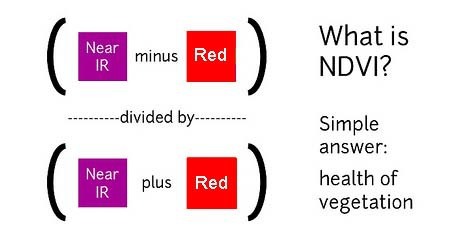](/i/44723) **NDVI = (Near Infrared - Red)/(Near Infrared + Red)** NDVI is a ratio which tries to emphasize photosynthesis while filtering out sun glare. The above equation is run for every pixel, using source data from an infrared photo and a visible light photo, like this pair: [](https://publiclab.org/system/images/photos/000/021/771/original/5390895115_c9d4d38fec_o.jpg) The result can be false-colored to make the high-photosynthesis areas more clear, and used to examine where plants are and how healthy they are. [](https://publiclab.org/system/images/photos/000/021/770/original/PetVISNDVIcomp.png) _Figure above: Normal color photo (right) and normalized difference vegetation index (NDVI) image (left). NDVI image was derived from two color channels in a single photo taken with a camera modified with a special infrared filter. Note that tree trunks, brown grass, and rocks have very low NDVI values because they are not photosynthetic. Healthy plants typically have NDVI values between 0.1 and 0.9. -- @cfastie_ ### Activities Here are a range of activities you can do to produce and interpret your own NDVI imagery, whether downloaded from a satellite imagery provider or [collected yourself using a DIY technique](/wiki/multispectral-imaging) [activities:ndvi] ****   Most DIY converted cameras today (those from Public Lab) use RGN instead of NRG, so the blue channel represents infrared instead of the red channel. That looks like this: [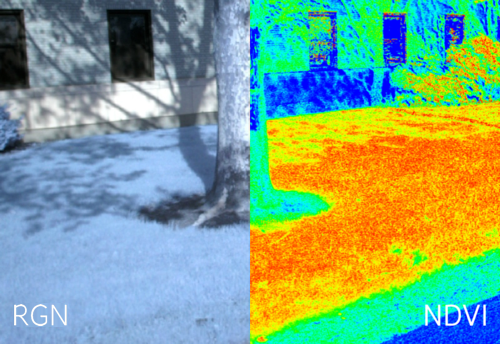](/i/45468?s=o) **** ## NRG imagery Some people are also interested in producing NRG imagery (like the below image), where `Near-Infrared, Red, and Green` are used to compose a picture instead of the usual `Red, Green, and Blue`. [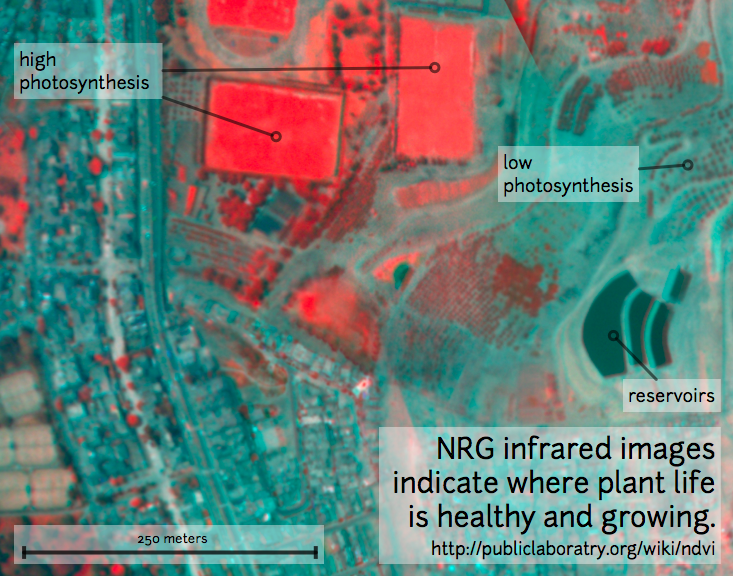](/i/25064) This diagram explains the swapping, which allows us to 'see' infrared as if it were a normal color: [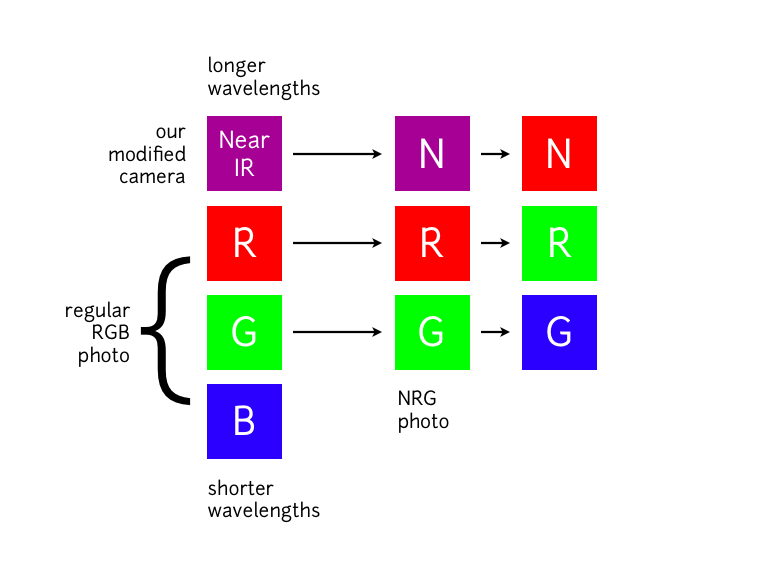](/i/25063) **In NRG images, the deeper and clearer the red color, the denser and healthier the vegetation (more or less).** ### Questions [questions:ndvi] ### Other examples of DIY NDVI imaging From around the internet: Begin watching at 2 minutes to see the resulting imagery: *This topic is part of the [Grassroots Mapping Curriculum](/wiki/mapping-curriculum) series.* **** [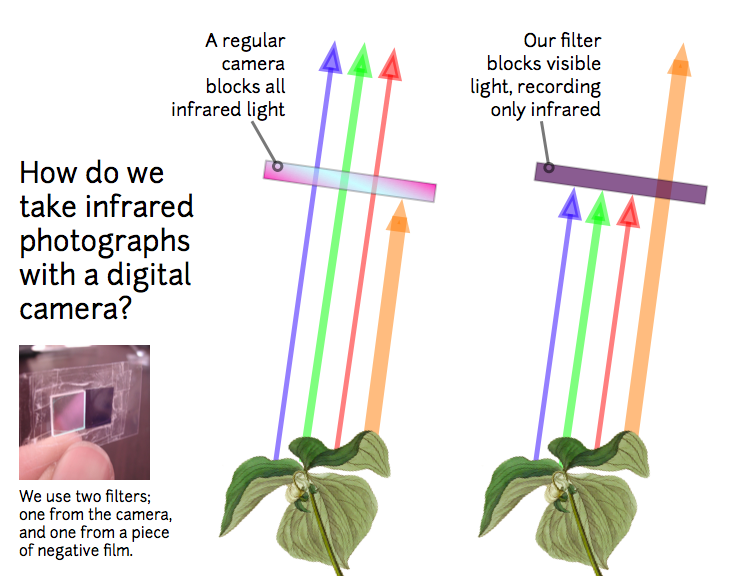](/i/25066) [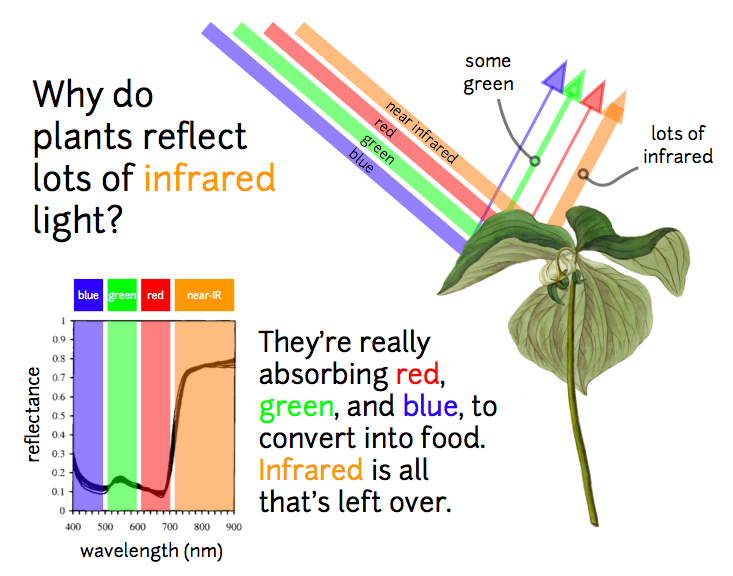](/i/25065) ...
| Author | Comment | Last activity | Moderation | ||
|---|---|---|---|---|---|
| cfastie | "Hi Rayishido, Nice Pi photos. Claytonb is correct about the shadows. It's a common artifact for dark areas to have very high NDVI values. In your ..." | Read more » | almost 9 years ago | |||
| Claytonb | "@Rayishido -the high NDVI values is a normal occurrence with shadows. You will notice that the NDVI values will change in the shadows depending on ..." | Read more » | almost 9 years ago | |||
| Claytonb | "@Thorsten - you are correct the images were mislabeled. Thanks for the heads up. I have corrected the labels. Thanks again, Clayton " | Read more » | almost 9 years ago | |||
| Thorsten | "@Claytonb, thanks for the test. I assume the images are correct but the channels in the image captions are somehow mixed up. I guess it should be: ..." | Read more » | almost 9 years ago | |||
| JacobNederend | "@nedhorning Today I rescued an old light source and integrating sphere from the scrap heap on campus. I don't think the light source is a monochrom..." | Read more » | almost 9 years ago | |||
| cfastie | "Okay, looks good. You just have to put carriage returns or two spaces after a line or an image to make it insert a return. " | Read more » | almost 9 years ago | |||
| Claytonb | "The filter size I have in the Canon S100's are 8.9 X 7.9 X 1. The sensor screws are each backed out approximately 3/4 turn from the factory positio..." | Read more » | almost 9 years ago | |||
| Claytonb | "@cfastie Apologies Chris I had to fix the image layout and labels and couldn't edit right so I'm reposting.These are from the MidOpt DB 475/850 and..." | Read more » | almost 9 years ago | |||
| cfastie | "Wow, the 660/850 camera focuses well across the image. That's good to know it can be done with a 1.0 mm thick filter. The 475/850 camera looks a li..." | Read more » | almost 9 years ago | |||
| cfastie | "Hi @Claytonb, That's good to know. Did you compare the different channels to see if some showed any vignetting? A photo of an evenly lit solid fie..." | Read more » | almost 9 years ago | |||
| Claytonb | "@cfastie -I can confirm that mounting the filter internally does correct the vignetting problem. I have mounted a DB475/850 and DB660/850 in place ..." | Read more » | almost 9 years ago | |||
| patcoyle | "Thoughtful discussion. Thanks. " | Read more » | almost 9 years ago | |||
| sneves | "Hi! The software was transfered to another website( www.spn-eg.com ). There you can acess more information about software or contact with me to im..." | Read more » | almost 9 years ago | |||
| DFlores6073 | "I use Fiji with the photomonitoring plugin...I would like to create a legend with the values, what would be AWSOME is to have the values on the ima..." | Read more » | almost 9 years ago | |||
| jtuhtan | "Hi David, The code I used was MATLAB, overlaying an image of the Fastie colormap onto the NDVI image. What software are you working with? " | Read more » | almost 9 years ago | |||
| DFlores6073 | "Jeff (Jtuhtan) could you please direct me to the right place so I can create a legend with values on my NDVI photos... Thank You David " | Read more » | almost 9 years ago | |||
| cfastie | "I hadn't considered aperture as a reason for the vignetting. I assume it is related to the angle at which the light enters the filter. Dichroic fil..." | Read more » | almost 9 years ago | |||
| Claytonb | "@cfastie -Hi Chris, Is it possible that the vignetting your seeing is related to wavelength interference due to aperture size? Have you tried a lar..." | Read more » | almost 9 years ago | |||
| cfastie | "I think the Public Lab Store will ship filters to Europe: https://store.publiclab.org/collections/diy-infrared-photography/products/infragram-diy-f..." | Read more » | about 9 years ago | |||
| GFFchris | "Hello, I wanted to ask if anyone has an idea on how to order the Rosco filter to Europe / Germany? Many Thanks! " | Read more » | about 9 years ago | |||
| cfastie | "I took another batch of photos (research note soon) with ISO 200 and the shutter speed at 1/30 second. The f-stop varied between f/2 and f/5.6. It ..." | Read more » | about 9 years ago | |||
| Claytonb | "@cfastie -Great work Chris. Have you tested to see what your max shutter speed is with the DB filter on a normal sunny day with same ISO or slightl..." | Read more » | about 9 years ago | |||
| Monoxyde | "Hi Parth, I agree with Chris, also it seems to me to see that the camera has a problem focusing. If you do not get images in focus, it could be th..." | Read more » | about 9 years ago | |||
| cfastie | "Hi Parth, The primary difference between your two photos is exposure. The bright one is overexposed. If there is software that allows you to contr..." | Read more » | about 9 years ago |